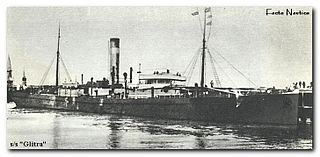
SS California was a twin-screw steamer that D. and W. Henderson and Company of Glasgow built for the Anchor Line in 1907 as a replacement for the aging ocean liner Astoria, which had been in continuous service since 1884. She worked the Glasgow to New York transatlantic route and was sunk by the German submarine SM U-85 on 7 February 1917.

SS Glitra was a steam cargo ship that was launched in 1881 as Saxon Prince. In 1896 she was renamed Glitra. In 1914 she became the first British merchant vessel to be sunk by a U-boat in the First World War.
SM U-66 was the lead ship of the Type U-66 submarines or U-boats for the Imperial German Navy during World War I. The submarine had been laid down in Kiel in November 1913 as U-7, the lead ship of the U-7 class for the Austro-Hungarian Navy. They became convinced after the outbreak of war in August 1914 that none of these submarines could be delivered to the Adriatic via Gibraltar, and sold the entire class, including U-7, to the German Imperial Navy in November 1914.
SM U-78 was one of the 329 submarines serving in the Imperial German Navy in World War I. U-78 was engaged in the naval warfare and took part in the First Battle of the Atlantic as a minelayer. On 27 October 1918 low frequency communications from U-78 in the Skagerrak were detected by the British submarine HMS G2 which sank her with the loss of her crew of 40. The commonly listed sinking date of 28 October 1918 is in error.
SS Vigrid was a Norwegian steam-powered cargo ship built in 1915. Sailing during the First World War, she was torpedoed and sunk without warning by a German U-boat on 31 December 1917.

SS Lanthorn was a 2,299 GRT cargo ship built in 1889 as SS Magnus Mail, renamed in 1916 and sunk by enemy action in 1917. She was a combined steamship and two-masted sailing ship.
SS Creekirk was a cargo steamship that was built in Scotland in 1912 and sunk with all hands by a German submarine in 1940. At her launch in 1912 she was named SS Mariston. In her 28-year career she was renamed SS Milcovul in 1913, SS Hyphaestos in 1933 and SS Creekirk in 1938.
MV Glenartney was a Glen Line cargo twin-screw motor ship that was launched in Scotland in 1915 as Montezuma, renamed Glenartney when she changed owners, and sunk by a U-boat in 1918.
SS Cuxhaven was a cargo ship built for the Yorkshire Coal and Steamship Company in 1882.

SS Rotorua was a New Zealand Shipping Company steam ocean liner and refrigerated cargo ship that was built in Scotland in 1910 and sunk by a U-boat in 1917.
SS Tregarthen was a cargo steamship that was built in Scotland for the Hain Steam Ship Co in 1936. She was sunk with all hands by a U-boat in 1941 in the Battle of the Atlantic.
SS Graciosa was a small freighter built during the First World War for James C. Gould and Co. under the name of Greltoria. Completed in 1917, she was sold while fitting out to the Bromport Steamship Co. and renamed Rabymere for use on their West African routes. The ship was sold to the Moss Steamship Co. in 1923 when the Lever Brothers closed down Bromport and sold off its ships. Moss renamed the ship as Edfou before selling it to Skibs A/S Fjeld in 1929 who renamed it Graciosa. During the Second World War, the ship was badly damaged during the Bombay Docks Explosion in early 1944 and was declared a constructive total loss and subsequently scrapped.
SS Colemere was a small freighter built during the First World War. Completed in 1915, she was intended for the West African trade. The ship was sunk by the German submarine SM U-105 in December 1917 with the loss of four crewmen.
SS Delamere was a small freighter built during the First World War. Completed in 1915, she was intended for the West African trade. The ship was sunk by the German submarine SM U-70 in April 1917 with the loss of 10 crewmen.
SS Eskmere was a small freighter built during the First World War. Completed in 1916, she was intended for the West African trade. The ship was sunk by the German submarine SM UC-75 in October 1917 with the loss of 20 crewmen.
SS Redesmere was a small freighter built during the First World War. Completed in 1915, she was intended for the West African trade. The ship was sunk by the German submarine SM U-70 in October 1917.
SS Thorpehall was a small freighter built before the First World War. Completed in 1910, she was intended for the West African trade. During the Spanish Civil War of 1936–1939, the ship was sunk by Nationalist bombers in May 1938.
SS Ellesmere was a small freighter built during the First World War. Completed in 1915, she was intended for the West African trade. The ship was sunk by the German submarine SM U-20 in July 1915.
SS Esemplare was a small freighter built during the first decade of the 20th century. Completed in 1902, she was intended for the West African trade. Sold to an Italian company shortly before the beginning of the First World War in 1914, the ship was captured and scuttled by the German submarine SM UC-27 in August 1917.
SS Saturn was a small freighter built before the First World War. Completed in 1906, she was intended for the West African trade. The ship was captured and scuttled by the German submarine SM U-57 in October 1916.



